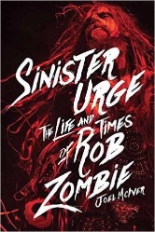 In Sinister Urge: The Life and Times of Rob Zombie, metal music bio specialist Joel McIver considers the career of the Renaissance man not content to constrain his talents to just one medium. If the Backbeat Books hardcover focused solely on Rob Zombie’s music — from White Zombie to his current solo act — I wouldn’t have been interested, but luckily, his forays into filmmaking are covered almost in as much depth. While the weight given to each movie is wildly off-balance, fans can learn a lot about the battles to make 2003’s controversial House of 1000 Corpses and the even more controversial 2007 remake of Halloween, and yet may be left wanting more about comparatively glossed-over subjects, such as the film-within-a-film excised from 2012’s The Lords of Salem or the clashes with David Caruso while shooting a CSI: Miami episode — I mean, tell me you don’t wanna hear everything about that! I assume this is because McIver had to draw upon existing sources since Zombie was not interviewed specifically for the book, so to judge what is there, which includes his absolutely crazy comics, I give it a thumb up rather than a middle finger.
In Sinister Urge: The Life and Times of Rob Zombie, metal music bio specialist Joel McIver considers the career of the Renaissance man not content to constrain his talents to just one medium. If the Backbeat Books hardcover focused solely on Rob Zombie’s music — from White Zombie to his current solo act — I wouldn’t have been interested, but luckily, his forays into filmmaking are covered almost in as much depth. While the weight given to each movie is wildly off-balance, fans can learn a lot about the battles to make 2003’s controversial House of 1000 Corpses and the even more controversial 2007 remake of Halloween, and yet may be left wanting more about comparatively glossed-over subjects, such as the film-within-a-film excised from 2012’s The Lords of Salem or the clashes with David Caruso while shooting a CSI: Miami episode — I mean, tell me you don’t wanna hear everything about that! I assume this is because McIver had to draw upon existing sources since Zombie was not interviewed specifically for the book, so to judge what is there, which includes his absolutely crazy comics, I give it a thumb up rather than a middle finger.
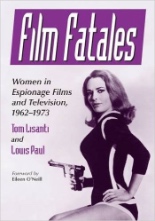 Women? Gotta love ’em. Women in spy movies? Gotta lust over ’em! And Tom Lisanti and Louis Paul’s tag-teaming of Film Fatales: Women in Espionage Films and Television, 1962-1973 damn near covers every one of the genre’s notable and/or nubile beauties: Raquel Welch, Lana Wood, Diana Rigg, Ann-Margret, Ursula Andress, Susan Hart, Honor Blackman, Tina Louise, Stella Stevens, Anne Francis … it’s the rare book that prompts the need of a cold shower. More than 100 of these starlets — seemingly half of them from James Bond adventures — are featured in their own few-pages-apiece chapters, profiling their careers overall and specific highlights from their filmographies. Generously supplemented with a nice photograph, they’re like IMDb entries with more depth and more flesh. Because of this setup, few will want to tackle Film Fatales cover to cover, opting instead to read up on the women with whom they’re most, um, “familiar.” But trust me: You’ll want to thumb through all the pages just for the photos alone. Unfortunately, so will your teenage brother/nephew/whoever, so hide it if you can. And if you cannot, good news: Originally published in 2002, this new reissue from McFarland & Company is close to half the price in paperback.
Women? Gotta love ’em. Women in spy movies? Gotta lust over ’em! And Tom Lisanti and Louis Paul’s tag-teaming of Film Fatales: Women in Espionage Films and Television, 1962-1973 damn near covers every one of the genre’s notable and/or nubile beauties: Raquel Welch, Lana Wood, Diana Rigg, Ann-Margret, Ursula Andress, Susan Hart, Honor Blackman, Tina Louise, Stella Stevens, Anne Francis … it’s the rare book that prompts the need of a cold shower. More than 100 of these starlets — seemingly half of them from James Bond adventures — are featured in their own few-pages-apiece chapters, profiling their careers overall and specific highlights from their filmographies. Generously supplemented with a nice photograph, they’re like IMDb entries with more depth and more flesh. Because of this setup, few will want to tackle Film Fatales cover to cover, opting instead to read up on the women with whom they’re most, um, “familiar.” But trust me: You’ll want to thumb through all the pages just for the photos alone. Unfortunately, so will your teenage brother/nephew/whoever, so hide it if you can. And if you cannot, good news: Originally published in 2002, this new reissue from McFarland & Company is close to half the price in paperback.
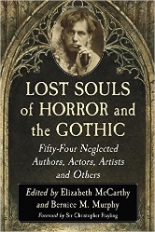 Also from McFarland, Lost Souls of Horror and the Gothic: Fifty-Four Neglected Authors, Actors, Artists and Others does just what it says. Edited by Elizabeth McCarthy and Bernice M. Murphy, this collection of biographical sketches is all over the place, but I suppose that is its point. While genre fans are likely to already know Rosemary’s Baby novelist Ira Levin, 1936 Sweeney Todd star Tod Slaughter and Just Before Dawn director Jeff Lieberman, even the most ardent enthusiasts may not be aware of the more obscure subjects, like illustrator Sidney Sime and author Marie Corelli. Bold choices include pop singer Danielle Dax, After Hours screenwriter Joseph Minion, Ghostwatch creator Stephen Volk and the team behind the Silent Hill franchise. Although the typical essay runs four pages, not even 100 times that amount would convince me that the legendary, double Oscar-winning actress Ingrid Bergman deserves a place among these Lost Souls.
Also from McFarland, Lost Souls of Horror and the Gothic: Fifty-Four Neglected Authors, Actors, Artists and Others does just what it says. Edited by Elizabeth McCarthy and Bernice M. Murphy, this collection of biographical sketches is all over the place, but I suppose that is its point. While genre fans are likely to already know Rosemary’s Baby novelist Ira Levin, 1936 Sweeney Todd star Tod Slaughter and Just Before Dawn director Jeff Lieberman, even the most ardent enthusiasts may not be aware of the more obscure subjects, like illustrator Sidney Sime and author Marie Corelli. Bold choices include pop singer Danielle Dax, After Hours screenwriter Joseph Minion, Ghostwatch creator Stephen Volk and the team behind the Silent Hill franchise. Although the typical essay runs four pages, not even 100 times that amount would convince me that the legendary, double Oscar-winning actress Ingrid Bergman deserves a place among these Lost Souls.
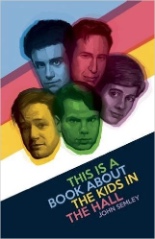 This is a review of This Is a Book About the Kids in the Hall, John Semley’s unimaginatively titled but perfectly readable biography of the venerable Canadian comedy troupe whose HBO series found a considerable cult. Published by ECW Press, the paperback delves expectedly into the Kids’ formation, dissolution and eventual reunion, but also reveals more about the members’ personal lives than I would have thought, particularly their upbringings, in which the running thread is “shitty dads.” The most interesting chapter chronicles the highly contentious making of the Kids’ first — and to date, only — feature film, the misunderstood 1996 flop Brain Candy (a movie I will defend to my dying day). Although the author inserts himself into the book too often and takes occasionally superfluous sojourns — the weak Kids in the Hall Drinking Game being the worst offender — I recommend any self-respecting KITH fan snap it up all the same, lest he or she risk a well-deserved head-crushing. —Rod Lott
This is a review of This Is a Book About the Kids in the Hall, John Semley’s unimaginatively titled but perfectly readable biography of the venerable Canadian comedy troupe whose HBO series found a considerable cult. Published by ECW Press, the paperback delves expectedly into the Kids’ formation, dissolution and eventual reunion, but also reveals more about the members’ personal lives than I would have thought, particularly their upbringings, in which the running thread is “shitty dads.” The most interesting chapter chronicles the highly contentious making of the Kids’ first — and to date, only — feature film, the misunderstood 1996 flop Brain Candy (a movie I will defend to my dying day). Although the author inserts himself into the book too often and takes occasionally superfluous sojourns — the weak Kids in the Hall Drinking Game being the worst offender — I recommend any self-respecting KITH fan snap it up all the same, lest he or she risk a well-deserved head-crushing. —Rod Lott

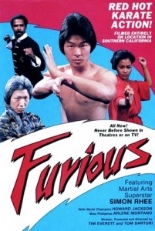
 Upfront, there is something you should know about
Upfront, there is something you should know about 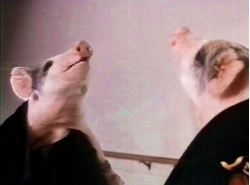
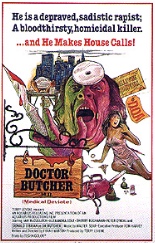
 Man oh man, do I ever love a movie in which an olive-complected hospital attendant gets caught literally red-handed, because he’s chomping on a heart freshly plucked from an on-the-slab body! But man oh man, do I ever love more a movie that then has that shamed, swarthy man hurl himself through a plate-glass window and to his death several floors below, the impact of which pops one of his arms clean from his torso. No worries — it’s back attached for his close-up, Mr. DeMille.
Man oh man, do I ever love a movie in which an olive-complected hospital attendant gets caught literally red-handed, because he’s chomping on a heart freshly plucked from an on-the-slab body! But man oh man, do I ever love more a movie that then has that shamed, swarthy man hurl himself through a plate-glass window and to his death several floors below, the impact of which pops one of his arms clean from his torso. No worries — it’s back attached for his close-up, Mr. DeMille. 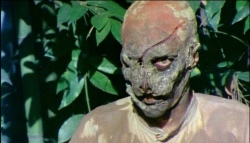

 So in
So in  Things get more twisted as Mary-Kate and Ashley search for a pig to roast. This essentially being a short film, they quickly come across one, sleeping. “Is it alive?” asks Mary-Kate (or maybe it was Ashley). “I don’t know! Let’s see,” replies Ashley (or maybe Mary-Kate; it does not matter). A cartoon light bulb appears over her head and she spots — and then grabs — a nearby stick that conveniently ends in a pencil-sharp point, which she then jabs into the swine’s where-the-sun-don’t-shine hole. As the animal jolts awake and squeals in equal parts terror and pain, the girls again just laugh and laugh.
Things get more twisted as Mary-Kate and Ashley search for a pig to roast. This essentially being a short film, they quickly come across one, sleeping. “Is it alive?” asks Mary-Kate (or maybe it was Ashley). “I don’t know! Let’s see,” replies Ashley (or maybe Mary-Kate; it does not matter). A cartoon light bulb appears over her head and she spots — and then grabs — a nearby stick that conveniently ends in a pencil-sharp point, which she then jabs into the swine’s where-the-sun-don’t-shine hole. As the animal jolts awake and squeals in equal parts terror and pain, the girls again just laugh and laugh. 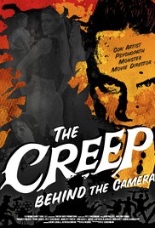
 Matching in ambition, Pete Schuermann’s
Matching in ambition, Pete Schuermann’s 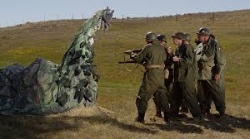 A former juvenile delinquent who never quite grew up, the bisexual Savage (who died in 1975) hustles and schemes and cheats his way through life and into grandiose dreams of Hollywood fame. That he has no discernible talent outside of fleecing others and abusing his long-suffering wife (Jodi Lynn Thomas, TV’s
A former juvenile delinquent who never quite grew up, the bisexual Savage (who died in 1975) hustles and schemes and cheats his way through life and into grandiose dreams of Hollywood fame. That he has no discernible talent outside of fleecing others and abusing his long-suffering wife (Jodi Lynn Thomas, TV’s